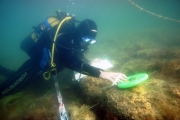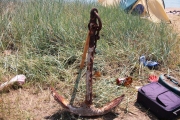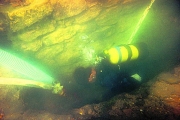|
Viewings: 5899
Near the village Naberezhne (Leninsky district) on a thin line - the camp of the expedition. Several tents and trailer not too attract attention of local residents and tourists. Many think it is located ordinary fans of rest savage, and few people know that there from mid-may live and work the scientists-archeologists from the Ukraine, Russia, Poland and Lithuania. Their attention is the Bosporan city of Acre."We are standing directly on the story, " says a diver expedition Evgeny Vodolazov. - Under the sand hidden part of the ancient city. Under us are three estates of the Roman period with streets, paved with stone. People simply had no idea that swim near the ancient settlement". The commander Viktor Vakhonev says that the AKP could not find: "an Interesting detail: from the Greek Acre literally translated as "hill" or "strengthening". By the way, hence the name of the Acropolis. The AKP all were looking at the highlands and the capes". And sensational discovery was discovered in 1982 at a depth of about three meters. And if you dive, you can see the ancient stonework walls policy that, and invited us to do the commander. "Because I can't tell you everything, as in the Museum show," laughs Victor and hands underwater mask. Previously dive I did not, but the scientist explains that you just need to dive deeper and be able to hold your breath for at least 15-20 seconds. The third time manages to consider defensive wall, which stretches along the shore. Deeper dive scary, and I see the AKP in the distance. Ruins overgrown with algae, and through the depths of the muddy water wall and does looks like a modern unfinished building in which it is hard to see the ruins of the ancient city, founded in the VI century BC Near the village Naberezhne (Leninsky district) on a thin line - the camp of the expedition. Several tents and trailer not too attract attention of local residents and tourists. Many think it is located ordinary fans of rest savage, and few people know that there from mid-may live and work the scientists-archeologists from the Ukraine, Russia, Poland and Lithuania. Their attention is the Bosporan city of Acre. "We are standing directly on the story, " says a diver expedition Evgeny Vodolazov. - Under the sand hidden part of the ancient city. Under us are three estates of the Roman period with streets, paved with stone. People simply had no idea that swim near the ancient settlement". The commander Viktor Vakhonev says that the AKP could not find: "an Interesting detail: from the Greek Acre literally translated as "hill" or "strengthening". By the way, hence the name of the Acropolis. The AKP all were looking at the highlands and the capes". And sensational discovery was discovered in 1982 at a depth of about three meters. And if you dive, you can see the ancient stonework walls policy that, and invited us to do the commander. "Because I can't tell you everything, as in the Museum show," laughs Victor and hands underwater mask. Previously dive I did not, but the scientist explains that you just need to dive deeper and be able to hold your breath for at least 15-20 seconds. The third time manages to consider defensive wall, which stretches along the shore. Deeper dive scary, and I see the AKP in the distance. Ruins overgrown with algae, and through the depths of the muddy water wall and does looks like a modern unfinished building in which it is hard to see the ruins of the ancient city, founded in the VI century BC AFRAID OF BLACK ARCHEOLOGISTS "Remember that little boy who found the coin? - asks the commander Viktor Vakhonev. He was trained to be an archeologist, came here in the 90-ies and headed the expedition. But then they had digged in the earth, which is very expensive. So after 1997 fifteen years was not conducted. Last year, here we are. Before we actively none of work under the water did not hold. Our goal is to learn the power of cultural layers. Very surprised incredible preservation of the city. Over the past two years found a large number of architectural structures: the walls in three or four numbers of a laying, various openings, street grid. But we still have not dokopalis to the bottom. Under us at least another half century of existence of the city." However, to the delight of archaeologists mixes and fear for the safety of the ruins, because black archeologists and treasure hunters can disassemble the AKP on the rocks, as soon as the expedition will leave the territory. "Diving was a public amusement, so the robbery has increased, - says Victor. - Leaving acre per year, of course we were worried that this will begin a pilgrimage robbers". The scientist expressed the hope that after the AKP fully investigate, to see the old policy will be able to attend during the diving excursions. Ekaterina Sereda segodnya.ua  Com-Eva: 0 Com-Eva: 0
You are reading news Экспедиция в город на дне Черного моря: каменные усадьбы, колодец и сокровища
if You liked the article Экспедиция в город на дне Черного моря: каменные усадьбы, колодец и сокровища,
prokomentiruet her.
|
The world of the unknown - Onua.org
Onua.org - this site created to familiarize the user with the world of the unknown, news of technology, space discoveries and mysteries of the Earth UFO, Video , Photo, the Witnesses, the mysteries of history and ancient civilizations.
Menu
- Anomalies
- Hypothesis
- The Mysteries Of History
- Unknown
- News
- Opening
- Top secret
- Prophets
- Ancient civilizations
- Egypt
- Rome
- Greece
- Anunaki
- Nazca
- Maya
- Cosmos
- Technology
- Flora and Fauna
- Atlantis
- Bermuda triangle
- Aliens and UFOs
- Cloning
- Loch Ness
- Mysticism and Magic
- Time machine
- Parallel world
- The Tunguska meteorite
- Third Reich
- Teleportation
- Snow man
- 2012
- Nibiru
- Solar system
- The sun
- Earth
- Mars
- The rest of the planet
- Photo
- Video
- A little about everything
- Украинские аномалии
- 2013-2014 YEAR
- Questions and answers
- 100 great
Interesting
Recent VIDEOS
News calendar
Join
Popular Onua.org
Photo

The biggest fish in the world - not blue whale as one might think, because the whale belongs to a ma

Before it was invented fridge, its functions were performed in the ice, which was considered a preci
Предлагаем восстановить, заказать, купить диплом Вуза в любом городе России. Только настоящий бланк ГОЗНАК с гарантией.















